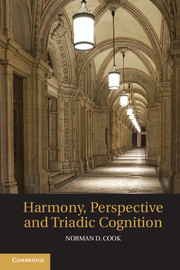3 - Human Seeing: Perspective
Published online by Cambridge University Press: 05 August 2012
Summary
There was a simplicity to the analysis of musical harmony arising from the fact that pitch is one-dimensional: Tones are high or low or somewhere in-between. In contrast, there is an inevitable complication in studying visual depth perception due to the two-dimensional structure of the visual scene (and retinal array). Solely because of this added spatial dimension, a relatively large number of elementary configurations of visual cues must be examined in order to determine the effects of vertical and/or horizontal displacement of shapes in the visual field on our sense of 3D depth. Despite this problem, the ways in which small numbers of cues are combined can be delineated, and a coherent account of the factors underlying visual depth perception can be arrived at. As was the case for the study of harmony, it will again be necessary to go step by step through two-cue, three-cue and many-cue effects in order to build up an explanation of the overall perception of the illusory 3D space in 2D artworks.
Before addressing the question of how we see depth in static 2D pictures, let us first ask how we see 3D structure in the 3D world. Given the capability to identify individual objects at a distance from their visual appearance – and inevitably to evaluate their relevance to the seeing organism, reconstruction of the surrounding world becomes of value. A major, ongoing task is therefore to identify which of numerous visual objects are near at hand and which are in the more distant periphery. Objects that are close provide opportunities for and dangers from direct interaction, whereas more distant objects can be safely ignored or pursued later. Because of the obvious importance of such long-distance perception, it is no surprise that a variety of mechanisms have emerged in evolution – from the bat’s sonar “vision” to the eagle’s telescopic sensitivity. One way or another, it is important for animals to learn at short notice of the dangers and opportunities in the immediate 3D environment.
- Type
- Chapter
- Information
- Harmony, Perspective, and Triadic Cognition , pp. 120 - 174Publisher: Cambridge University PressPrint publication year: 2011



